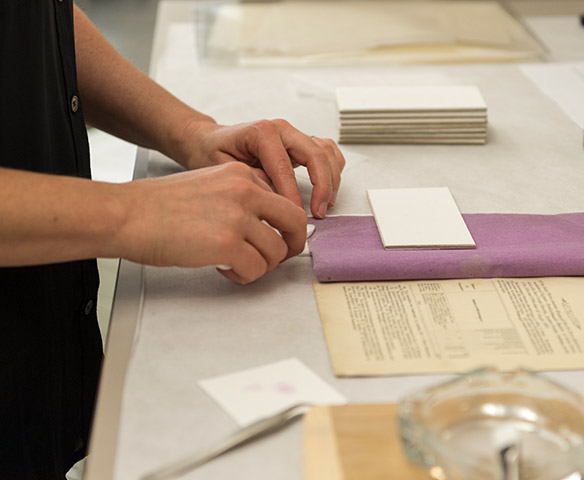
Purchase Tickets
Long underwear? A Unique Story to Celebrate Preservation Week!
April 27, 2020

The Indiana Historical Society’s Archive staff receives donated collections all the time, and first look to see if the papers or photographs come in some sort of order. That way if an original arrangement does exist it can help make sense of what may seem like a random assortment.
One time we received an entire family’s correspondence from their farmhouse packed away inside two pair of full body long johns. Normally I have a camera when we receive new collections; but darn if I didn’t have one that day! I think we were all so surprised when we pulled those long johns out of that bag – and all those little tied bundles of letters stuffed everywhere right down the arms and legs … we were just too curious and very amused.
The story of the long underwear makes a point though; these letters – easily over a thousand in number from 1781 through 1984 – were extremely well preserved. The ‘housing’ helped retain a certain sense of order to the bundles, and the bundles themselves were in order by date. The long underwear protected the envelopes – the fabric itself was clean – so it had been stored in a good, dry space – no basement, attic or barn!
I am going on here a bit, but as a conservator I can call this family true preservers of their family history.

The discovery of a collection of old family letters and documents usually brings about a feeling of curiosity and anticipation, quickly followed by questions about how to preserve them! One way to do that is to recognize any existing order. Preserving original order (by name, date run, place) could save time by making sense of what can be a wide assortment of ‘things.’
All collections are unique and can contain items of special significance considering the context: Why this postcard was sent from there? Where is this farmhouse located? Who is that with my brother? Why is this collection stored in long johns?
Upon casual notice the condition of the collection can vary. Letters may still be tucked inside envelopes, items may be rolled, torn or have tears covered by tape. These are the kinds of things that happen to family papers and their presence is tolerated over time, but unfortunately, not very well. In the long run, to avoid repeated handling that can cause creases to tear, papers are removed from envelopes and stored flat. Because staples and paper clips rust, keeping a letter with its envelope is done by folding a piece of acid-free paper around the two.
Depending on age, papers may be yellow or brittle, and the very idea of unfolding a letter makes one uneasy. When this is the case, our conservation staff at the Indiana Historical Society can coach you on how to best proceed as you first handle your fragile papers.

Using tape on torn areas will yellow and stain paper. It also gets sticky with age, causing a lot more damage than the original tear. If paper is torn, support it between to sheets of acid-fee paper or inside a Mylar sleeve to stabilize the torn area.
To close on the subject of preservation storage – when long johns won’t do – acid free folders and boxes are your best bet to safely house your family collection. If you have questions about saving your family’s items, here is a link to our resources page.









